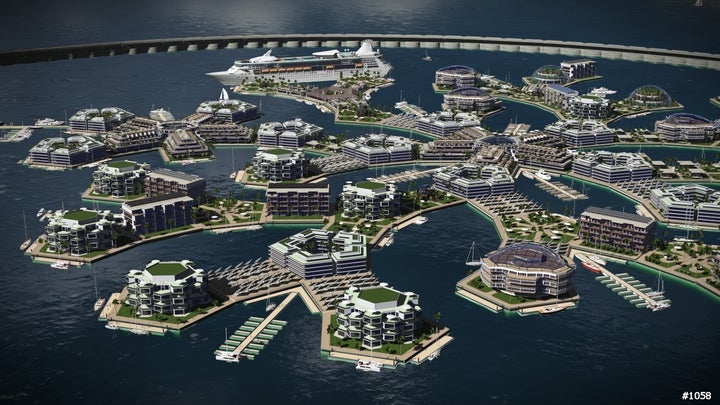
One proposed design for a Seastead.
Tesla and SpaceX founder Elon Musk recently announced grand – and expensive – plans for humans to populate Mars in the near future. But what if there were a more practical way to inhabit another frontier, using the atmosphere we already have, and in the process to create a platform for developing the tools and innovations to help us adapt to climate change?
Randolph Hencken is the executive director of an organization seeking to do just that. His Seasteading Institute – founded in 2008 by Patri Friedman with funding from Paypal founder Peter Thiel – is approaching a breakthrough period in its development, and, according to Hencken, is now realistically on target to have the first people moving into a floating, sea top community by 2020.
While some critics have derided seasteading as a fantastical venture and belittled the ambitions because of ideological disagreements – founders Friedman and Thiel are noted supporters of libertarian-inspired philosophies — Hencken said he is excited about the possibilities of seasteading to inspire hope, capture imaginations, and serve as a practical platform for developing innovative solutions to many global crises. “Government is just another type of technology,” Hencken said in an interview. Technology that Hencken and his supporters believe is broken and ripe for disruption.
Seasteading is basically the idea that humans can build habitable cities on the ocean. The technology to make this a reality exists, but Hencken said the costs of building on the open ocean – because of the physics of ocean waves – are prohibitive. To overcome this challenge, the Seateading Institute needed a partner region that would permit them to build in their littoral zone. Hencken explained that French Polynesia’s Council of Ministers has recently approved a memorandum of understanding (MOU) that they will all sign in January in San Francisco. This MOU will establish an offshore special economic zone giving the Seasteading Institute a space in which to build, in exchange for sharing the economic and social benefits of building a new community. The agreement pending now is that French Polynesia will pass a special jurisdictional framework in their legislature that will become law in 2017. Once this law exists, the Seasteading Institute can begin construction, with plans to be on the ground in Tahiti with materials and labor in 2018.
Comparing government to a broken technology, Hencken explained that the existing 193 countries simply do not provide the breadth of individuality of 7.3 billion people, and that by providing new territory in a new frontier, you create a platform for innovators to pioneer new and experimental forms of governance. He compared seasteading to the new frontier of America, which was created by people leaving tyranny to build a new model, after which democracy spread around the world. Plus, he said, “people can come and see how they like it, take lessons they like, and if we fail, we fail alone.”
Apart from experimenting with innovations in governance, Hencken is also excited about the potential for seasteading to serve as a platform for developing tools to help with climate change adaptation as well.
Low-lying islands in the Pacific, like Kiribati and parts of French Polynesia, face the imminent threat of disappearing because of sea level rise. Hencken believes that seasteading offers one practical solution for these places to create new, resilient territory on which to continue to exist. This is an angle that piqued French Polynesia’s interest, which is why they’ve allowed the Seasteading Institute to build a floating pilot that can be replicated while getting plugged into French Polynesia’s economy and supply chain. Hencken looks forward to working with French Polynesia’s youth in building new ocean tech that can benefit the island nation and subsequently be spun out to places in need of new land. He said that once they’ve built a successful pilot, he can imagine deploying similar seasteads to places like Miami and Bangladesh.
Once constructed, Hencken and his team anticipate their floating community can become a hotbed of oceanographic and climate resilience research and implementation, including everything from experimenting with wave and tidal energy, to combatting rising ocean heat and acidification, to pioneering new ways to trap atmospheric carbon on the sea floor. “The possibilities are endless,” he said.
In 2017, such a vision is much more realistic than it used to be. Hencken said 60 percent of people involved in development come from around the world, including India, Russia, South America, and elsewhere. The Institute is also plugged into a large maritime network. And, perhaps most importantly, one of the Seasteading Institute’s key partners, Dutch firm DeltaSync, has already built a working prototype on a port lake in the Rijnhaven section of Rotterdam, called the Floating Pavilion. This structure is powered by renewable energy and collects and purifies the somewhat salty Rotterdam water for use, returning it safely to the environment.
When asked how much living on a seastead would cost, Hencken was frank. “It won’t be cheap living,” at first. “DeltaSync completed their preliminary concept in December 2013. In their vision, [the initial inter-locking floating platforms that can house 20 to 30 people each] are estimated to cost approximately $15 million. Since 20 percent of each platform is reserved for open/green space, they project [livable] space to cost $504 per square foot ($5425 per square meter),” cheaper than current prices in Manhattan or Central London. But Hencken said that as more people move to the seastead, prices should gradually fall and more platforms can be built. He said to entice people to move the stead, they have to create a compelling use case, so that the community generates economic activity and encourages growth. They have many ideas, he said, including Internet-based businesses, being a home for “digital nomads who want to create software in paradise,” a conference center, tourist destination, plus serving as a pioneering vertical farming and aquaculture platform, in addition to building research relationships over time.
Despite the challenges, Hencken finds encouragement in their progress with French Polynesia, and the attention given to Musk’s Mars plan. “With seasteading, we can put tens of thousands or perhaps millions of people on platforms in our lifetime. [With Musk’s Mars plan], the reality of many people going in our lifetime is slim. It’s cool to colonize the solar system, but there’s an atmosphere on earth and we can live here. Oceans are the only place we’re not really living. We should own our own planet first, and it will be much cheaper. How many billions or trillions of dollars would it take to put dozens, not to mention thousands, of people on Mars?”
